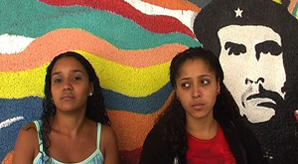The Dialectical Image
Listen To Venezuela is a film that has been made in the tradition of radical Latin American documentary. This tradition emerged in the 1960s in the context of the 1959 Cuban revolution and the subsequent wave of revolutionary struggles against the Latin American oligarchy and US domination. Film became a weapon in the political struggle, but a critical, interrogatory and sophisticated weapon, supported by an intellectual culture generated by the filmmakers themselves through a variety of manifestos and essays. The Latin American documentary broke with the social democratic model dominant in the west, and aligned itself with the struggles of the workers and peasants. The dialectical image was (re)born through this committed, aligned filmmaking from such people as Santiago Alvarez, Fernando Solanas and Octavio Getino.
The dialectical image is characterised by its ability to speak of social and historical processes, make connections between things and articulate contradictions and conflicts.
It does this frequently in an act of recovery, against the draining away of the social and historical, the social connections and the contradictions of life which is the hall mark of mass culture. The method of the dialectical image is various, but it generally involves composing images, or the relations between images and/or the relations between sound and images in such a way as to produce disjunctures and contradictions of meaning. This disjuncture opens up the space for critical thought and transformation, a re-organisation of pre-conceived ideas as the viewer works to identify and decode the social forces at work in the image at specific historical moments.
The dialectical image has its roots further back in time, in the film work of revolutionary Russian filmmakers such as Sergei Eisenstein, whose theory of film montage stressed the importance of shocking the viewer into new emotional and intellectual responses, and Dziga Vertov, whose theory of montage explored new perceptions opened up in the space between shots. But for the dialectical image to work, it needs to be part of a general dialectical film structure, and not an isolated moment. There are many examples of such isolated moments of dialectical awareness in mass film culture, but they cannot be developed by the film or the spectator because the potential of such moments is quickly closed off and reintegrated into dominant ideologies.
For example, in King Kong (Peter Jackson 2005), the film opens with scenes of the mass poverty caused by the Great Depression. We see the shanty towns that sprang up in New York’s Central Park and this is juxtaposed with a song (contemporary to that era) from Al Jolson, called ‘I’m Sitting On Top Of the World’. This song provides an ironic juxtaposition between the utopian claims of the lyrics and the reality of hunger and homelessness for many people after the Wall Street Crash in 1929. We also see images of people who, despite the crash, are still sitting on top of the world: the rich. So the song provides an ironic and critical counterpoint to this image as well: the song’s utopian theme becomes a comment on the selfishness and indifference of the rich. But fairly quickly, the critical dialectical friction being generated by these images and this soundtrack, is neutralised as the film succumbs to racial and imperial myths deeply embedded into western culture.
an example
The dialectical image does not necessarily require fancy editing to bring it about, especially in a context such as Venezuela, where a revolutionary dialectic is already happening. The dialectical image can be made within the composition of a single shot. In the chapter on education, Listen To Venezuela focuses on the Bolivarian University, a revolutionary university set up by the government in 2003, to provide education to the poor majority who have been excluded from university level education by the elite universities.
This image is a dialectical one. In it it these young women from the barrios, talk about how the revolution and the university have opened up the chance to study for degrees, a chance that would have been once denied to them. Behind them is a rainbow version of the famous iconic image of Che. This image has now achieved a kind of mythical status, endlessly recycled in many settings, some of them far removed from the revolutionary aims of Che Guevara. It is in short an image that has been almost removed from its historical and political moorings. In addition, Che has acquired certain associations connected with the image of the guerilla fighter, a romanticisation of the macho fighter and of political violence and sacrifice. What our image does is to bring that iconic image back down to earth and (re)connect Che with some of the concrete aims of social transformation and widening of horizons and possibilities that he was fighting for. These young women are the direct beneficiaries of a long continent wide struggle in which Che played an important part.
